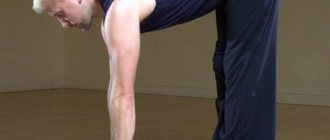What is a cool-down, and why is it called that?
Cooling down is exercise after running. It essentially contradicts all the training done before it. If we increase our heart rate during the training process, a cool-down helps it return to its normal state. During the training process, the muscles tense and work more actively . When you cool down, their activity slows down and gradually returns to a state of rest.
A cool-down is essentially a simple post-workout stretch with some light cardio thrown in. It helps normalize pulse and body temperature. Thus, we can say that it is a warm-up performed exactly the opposite.
Main activities
An experienced athlete knows that before a run, the body should be warmed up. Muscles that are in a stretched state are a good factor for stretching, since during this interval the muscle fibers stretch well.
Set of exercises:
Slowly lowering the head down, turning up and to the sides
At maximum tension, you need to touch your hand above your temple to feel how the neck muscles are stretched. With your right hand you press on the temple on the left, with your left hand on the temple on the right.
Side bends
Keep your right hand on your belt and raise your left hand above your head. After performing 25 times, you should change hands.
Pulling the ankle with both hands, bending towards the leg
After several exercises, the position of the hands is changed.
Performing splits to tension the inner femoral surface.
For convenience, you should rest your hands on a horizontal surface.
Spring Lunges
You need to try to make them as wide as possible.
What is it done for?
During physical activity, and running is no exception, lactic acid is produced and accumulated in the muscles. Because of this, characteristic muscle pain is felt, called soreness. Doing a warm-up after exercise helps restore muscles and relieve muscle fatigue.
Cooling down while running performs the following tasks:
- normalization of pulse and body temperature;
- decreased levels of lactic acid in muscles;
- stress relief;
- restoration of normal blood circulation;
- normalization of the tone of intramuscular veins.
Athletes argue that stopping suddenly while running fast is unsafe , since the cardiovascular system will experience severe stress.
Thanks to the cool-down, the body smoothly returns to a state of rest, normal breathing is restored, and the emotional state returns to normal.
IMPORTANT! Cool down should be done immediately after running. It won't be a big deal if a couple of minutes pass and the athlete catches his breath after a run. If the run was not fast, you can cool down after the finish. However, if you do not start a cool-down within five minutes, the effect will be significantly reduced. And during this time, the pulse may drop below the limit that the cool-down implies, but it is aimed precisely at moving from activity to rest.
The benefits of running
Probably, many people are attracted to jogging mainly because it is the most accessible form of physical education. Sports uniform and a place to practice - that's all you need.
Running brings many benefits to the body:
- Metabolism stimulation;
- Strengthening the circulatory system;
- Normalization of the digestive system;
- Elimination of oxygen starvation and, as a result, prevention of cancer;
- Slowing down the aging process;
- Increased performance and endurance of the body.
And most importantly, running helps you lose excess weight and helps you get a beautiful figure.
However, often people do not know what not to do after running, and therefore suffer from leg pain, weakness and dizziness.
How to avoid these unpleasant phenomena? You just need to know the secrets of proper jogging, which we will talk about in this article.
What exercises should I do?
Cooling down after a run most often consists of low-intensity cardio and stretching. The simplest, and at the same time useful option is jogging. That is, after finishing the main run, you do not stop, but gradually reduce your running pace.
This helps reduce stress, restore the functioning of the cardiovascular, respiratory and other systems, and remove remaining lactic acid from the body. Even ten minutes of easy running with a heart rate of up to 120 beats per minute is enough for full recovery.
When cooling down, exercises aimed at stretching, flexibility, and strengthening ligaments and joints . They are mostly static, so you can start doing them immediately after running.
Beginning runners can use regular walking as a cool-down. Its duration should be standard - about 10-15 minutes. From a fast pace you need to move to a smooth slowdown.
Here are some examples of exercises suitable for cool-down:
- Bend over from a vertical position and place your palms on some support. Stretch your chest towards the floor without lifting your arms. The knees should be straight.
- Press your forearm against the door frame or exercise machine counter at chest level. Lean your body forward, stretching your shoulder joint. Repeat the same for the second hand.
You need to make a deep lunge on your right leg. The knee of the left leg is pressed to the floor. Raise your arms above your head and bring your palms together. You need to bend your back a little. Lock in this position for 15 seconds, change legs and repeat similar actions.- Place your feet shoulder-width apart and place your hands on your waist. Actively rotate your pelvis in different directions.
- Bends are performed in the same position.
The main idea behind the cool-down is that it should be done at a low heart rate. Therefore, you cannot run fast at this time. While doing the exercises, you can drink water - this will help replenish the body’s supply of fluids lost during the main exercise.
What not to do when warming up before running
Sometimes novice athletes make mistakes during physical exercise that reduce its effectiveness.
- Don't start your warm-up with stretching. For starters, simple aerobics exercises are more suitable.
- Don't pay too much attention to stretching during warm-up exercises. Remember: in this case, our goal is to prepare the ligamentous apparatus for loading, and not to do the splits.
- Cardio warm-up should not take more than 5 minutes - running itself puts a significant strain on the heart.
- You should not unreasonably increase the duration of the “warm-up” - 5-10 minutes is quite enough. If you turn physical exercise into a full-fledged half-hour workout, then you will no longer have the strength to do cross-country.
- When performing exercises, sudden, jerking movements are prohibited.
- You should not eat or drink a lot before warming up. You can only drink a little at a time if there is a significant loss of fluid during running. It's better to eat after finishing your run.
- You can't start your warm-up with stretching. Many people do lunges and rolls from foot to foot to warm up as much as possible. If you run in the evening, then similar exercises may still be suitable (if you walk a lot), but you should not do this before running in the morning.
- Don't focus on stretching. There is no need to comprehensively stretch the muscles; this does not give any effect; on the contrary, there is a possibility of injury. This is suitable for experienced runners, but for beginners it is enough to do simple exercises.
- Try not to eat or drink. Yes, in the morning you want to drink coffee, read a couple of news over tea and cookies, but if you intend to run, then it’s better to do all this after a run, that’s when our body needs to consume the energy it spent.
- Warm-up shouldn't be long. There are people who warm up for 20 minutes, then they have no energy, no time, no desire left to run. The ideal warm-up is 5-10 minutes, this is enough to warm up the muscles.
How to properly stretch muscles?
The cool-down usually involves stretching . It helps prevent muscle pain. Many girls involved in sports are afraid to overly pump up their leg muscles. Stretching will help prevent this and make your body contours more feminine. Also, such exercises are great for relaxing and returning the body to a calm state.
When performing stretching exercises, adhere to the following rules:
- You only need to stretch warmed muscles.
- Don't pull the muscles too hard. If pain occurs, stop.
- When stretching, sudden movements are not allowed. You need to stretch smoothly and slowly.
We offer several simple and effective stretching exercises:
- Neck. Smoothly turn your head to the side and hold in this position to feel the tension in the muscles. Repeat the same for the second side. In total you need to do 3-4 repetitions.
- Back. You need to bend your arm at the elbow, lift it up and put it behind your back. With your other hand, try to pull your elbow back. The shoulders should stretch, as well as the latissimus dorsi muscle. Similar actions are repeated for the second hand.
- Shoulders. The right hand needs to be moved to the left in front of the body. With your left hand, bring it closer to your body. The same must be done by changing hands. Hold in the extreme position for a couple of seconds.
- Side bends. They need to be performed smoothly and slowly, slightly lingering in the final position and moving slightly in the ground.
- Legs. The simplest exercise. You need to lay out the mat, sit down, spread your legs as wide as possible. Perform alternate bends to each of the legs, then to the center.
- Standing stretch. You need to bend one leg at the knee and pull it to your stomach with your hands and stay in this position. This will help relax the hamstrings and gluteal muscles.
- Reverse exercise. You need to put your bent leg back, grab your toe with your hand and reach for your buttocks. This way you stretch the anterior thigh muscle.
- To relax the lower leg, one leg should be bent at the knee, the second should be placed on the heel slightly in front. You need to grab the sock with your hand and pull it towards you. The back should be bent.
ATTENTION! During the stretching process, you should feel the muscles you are stretching.
What do trainers say about stretching?
As with many other topics, there is no general consensus on stretching among coaches, scientists and sports experts. However, the majority boils down to the fact that preliminary preparation in one form or another is absolutely necessary. But the forms and options for this preparation may differ.
Based on a study of the opinions of scientists and sports trainers, the following advantages of stretching before and after running can be deduced:
- Muscle preparation. We can definitely say that with the help of exercises it is possible to prepare the muscles for intense running training. Blood circulation improves, muscle tissue heats up, which reduces the likelihood of ruptures.
- Preparing the joints. The process is similar - the temperature in the joint tissues rises, the secretion of synovial fluid is activated, which prevents the occurrence of injuries.
- Outflow of blood. In a calm state, blood accumulates more in the organs. During stretching, it is directed into muscle tissue. This helps tailor your running workout to your body care, as improved blood circulation in the legs helps reduce the appearance of cellulite, for example.
- Acceleration of metabolism. Again, improved blood circulation is an opportunity to provide a more intense flow of oxygen to the tissues, and this is one of the key conditions for accelerating metabolism.
- Increased heart rate. While running, the heart works much more actively than when walking and, even more so, in a passive state. To maintain cardiovascular health, it is recommended to prepare in advance, which is where stretching helps.
Let's turn to the experience of one of the world's famous persons in the field of sports. Thus, Janet Hamilton, a certified strength and conditioning specialist and exercise coach at the Running Strong club in Atlanta, says that pre-stretching helps increase running speed and endurance. Good preparation also reduces the risk of injury by developing running movements and cushioning the impact. These points can be added to the list of advantages of stretching before running.
And finally, we can point out that after preliminary preparation, when the muscles and joints are in good shape, it is easier for a person to run quickly and for a long time, which means he will burn more calories.
As for the disadvantages of stretching, a maximum of three can be identified, and all of them are subjective:
- you will spend more time training;
- You will first have to learn how to perform the exercises correctly;
- mistakes in exercises can have the opposite effect, contributing to injury.
Learn to do stretching correctly - in this case, you will be able to avoid possible negative consequences.
How long does the cool down last?
The standard cool-down duration is 10-15 minutes. This is enough to restore the breathing rate and normal pulse, returning to a state of rest without stress for the body.
REFERENCE. If you run outside in cold temperatures, it is recommended to cool down indoors to avoid hypothermia.
How to complete your morning and evening runs
When is it better to run: in the morning or in the evening - everyone decides for themselves. The main thing to remember is that only proper organization of classes will bring benefits. Failure to follow these recommendations, on the contrary, may contribute to a decrease in the positive effect and injury.
What to do after running in the morning? If you decide to study in the morning , have breakfast before class. It should be a light meal: fruit and juice.
After warming up and walking a short distance, start running.
Finish your run with a walk, and when you return home, take a shower.
Evening jogging is not conducive to intense exercise; it can cause fatigue. Jogging would be ideal. What should you do after running in the evening?
After your workout, you can drink juice or snack on fruit. The main thing is to time your classes so that they end at least a couple of hours before bedtime. Late running will not bring any benefit; it will only cause insomnia, and as a result, depression.
Semyon Zhdanov
Master Trainer of Outdoor programs at World Class
Is there a fundamental difference between morning and evening running?
It is important to consider a person's lifestyle. Most likely, after the morning training, a full day of work awaits him. And he doesn’t need to kill himself in such a way that his body will be broken all day. Therefore, in the morning you need to start running slowly, gradually increasing the speed, but it should still be comfortable for the body. Running in the evening is different in that a person goes for a run after a full day of work. And you need to understand why he runs in the evening. Sometimes you don’t want to train, your motivation drops, but all these are illusions. When you start running, be sure to warm up first, blood flow will increase and fatigue will go away. You will even get rid of stress. But you shouldn’t go too far during an evening run: the nervous system may become overexcited, so it may be difficult to fall asleep.
When does the body burn more calories?
Of course, in the first half of the day, since our metabolism is accelerated and we are very active during this period of time. And if you also worked out in the morning, then burning calories occurs faster and more efficiently. But it’s worth taking into account the fact that the most calories are burned when we add wood to the stove: that is, we need to eat often and little by little, approximately every three hours. Then we will burn calories faster. You also need to understand what calories we burn: be it fat or glycogen in muscles. Pulse zones are already taken into account here, and, for example, if you train at low intensity, that is, it lasts from 60 to 90 minutes, you will be able to burn calories from fat. They first burn in the muscles, then, when we continue to be active during the day, eat often and the right foods (but this is a separate topic), the body begins to pull out subcutaneous fat and remove it into the muscles. This is how fat calories are burned.
How often and for how long should you run?
The question is interesting and rhetorical, but there are already some general developments. If we take the average person, less active, for example, an office worker or someone else with a sedentary lifestyle, then the frequency should be two to three times a week. This is an approximate minimum.
Duration from 30 to 90 minutes. And this should last for the rest of your life, since running is an innate quality, like eating or washing your face. Then the body will be healthy and strong. But here you need to take into account some points that running often and for a long time can be perceived by a person as special exhaustion of his body. Therefore, it is possible to alternate running with walking: run for a minute, walk for a minute. There is no need to make this a hard workout or challenge for yourself. Of course, you can occasionally strain yourself, but overall, running should be a pleasure and a joy.
What to do if you feel bad after a morning run?
You need to look for the reason: how a person runs, how long he trains, whether he exercises on an empty stomach or not, whether he gets enough sleep or goes to a bar in the evenings. To cope with poor health, you need to do the following: stay hydrated throughout the day and eat regularly. That is, you will find breakfast, lunch and dinner with snacks in between. If it becomes very bad, then try to set aside an hour during the day to rest (especially from gadgets). Of course, after this, take action, monitor your running and, perhaps, switch to walking in the future.
Why do most professional athletes prefer to run in the morning?
For almost all people, jogging in the morning is a ritual, exercise, and an opportunity to tune in for the day ahead. Professional athletes may still have at least two workouts per day. Therefore, a morning jog is just exercise, then they rest for two hours, and then they do the first workout, also for two hours. Then they rest again, have dinner and sleep. In the evening they go out for the second training session. If we talk about professional runners, they run three times a day with a heavy load.
Nutrition
You can eat immediately after training. Moreover, it is desirable that your food is rich in carbohydrates. Such foods include sugar, candy, raisins, rice, pasta, honey, bread, chocolate.
After an hour-long workout, you will need to restore about 50 grams of carbohydrates in the body. The above products contain approximately 50-60 grams of carbohydrates. per 100 gr. Therefore, choose the most convenient proportion of foods for yourself to restore the balance of carbohydrates.











